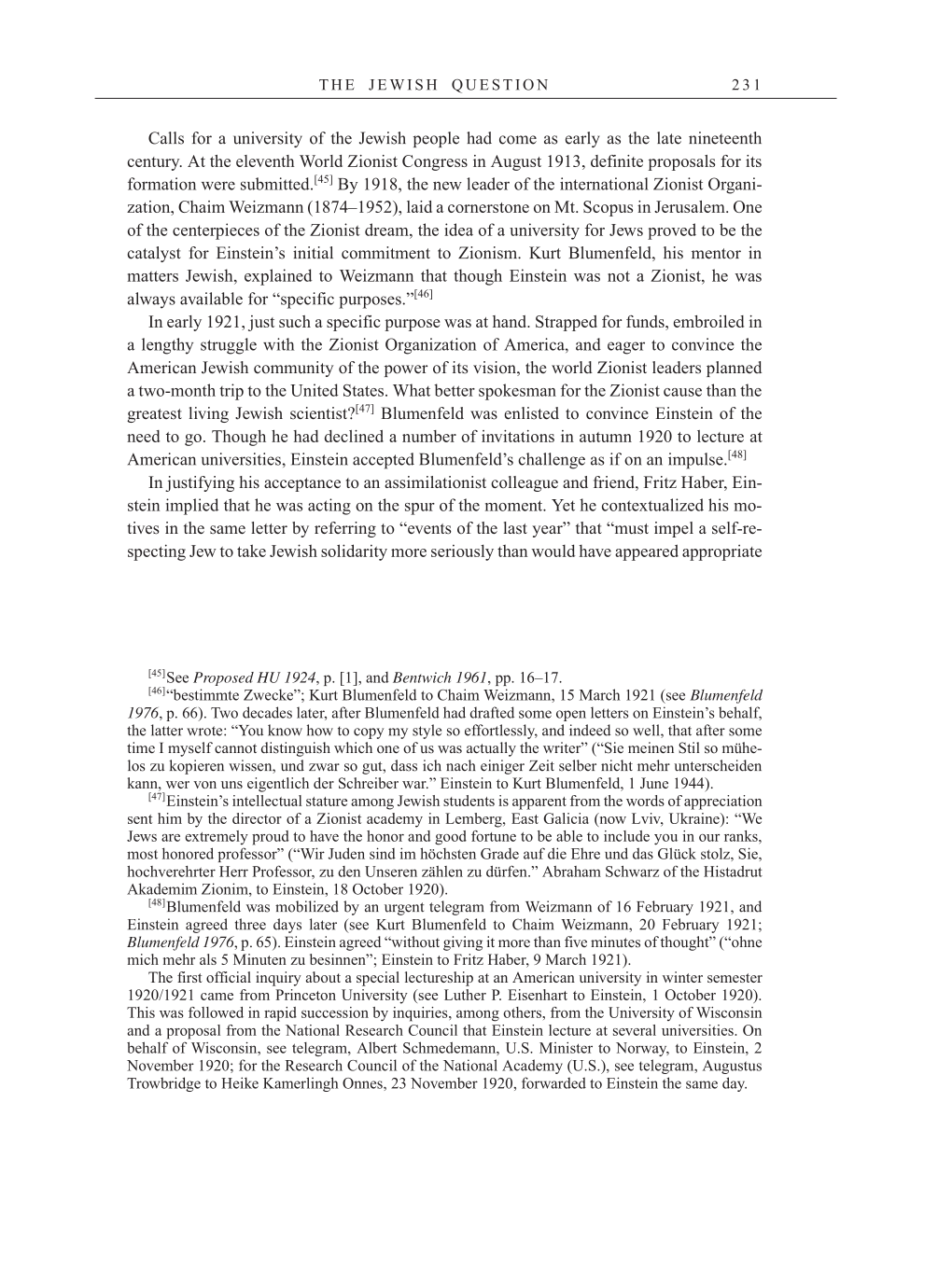T H E J E W I S H QU E S T I O N 2 3 1
Calls for a university of the Jewish people had come as early as the late nineteenth
century. At the eleventh World Zionist Congress in August 1913, definite proposals for its
formation were
submitted.[45]
By 1918, the new leader of the international Zionist Organi-
zation, Chaim Weizmann (1874–1952), laid a cornerstone on Mt. Scopus in Jerusalem. One
of the centerpieces of the Zionist dream, the idea of a university for Jews proved to be the
catalyst for Einstein’s initial commitment to Zionism. Kurt Blumenfeld, his mentor in
matters Jewish, explained to Weizmann that though Einstein was not a Zionist, he was
always available for “specific
purposes.”[46]
In early 1921, just such a specific purpose was at hand. Strapped for funds, embroiled in
a lengthy struggle with the Zionist Organization of America, and eager to convince the
American Jewish community of the power of its vision, the world Zionist leaders planned
a two-month trip to the United States. What better spokesman for the Zionist cause than the
greatest living Jewish
scientist?[47]
Blumenfeld was enlisted to convince Einstein of the
need to go. Though he had declined a number of invitations in autumn 1920 to lecture at
American universities, Einstein accepted Blumenfeld’s challenge as if on an
impulse.[48]
In justifying his acceptance to an assimilationist colleague and friend, Fritz Haber, Ein-
stein implied that he was acting on the spur of the moment. Yet he contextualized his mo-
tives in the same letter by referring to “events of the last year” that “must impel a self-re-
specting Jew to take Jewish solidarity more seriously than would have appeared appropriate
[45]See Proposed HU 1924, p. [1], and Bentwich 1961, pp. 16–17.
[46]“bestimmte Zwecke”; Kurt Blumenfeld to Chaim Weizmann, 15 March 1921 (see Blumenfeld
1976, p. 66). Two decades later, after Blumenfeld had drafted some open letters on Einstein’s behalf,
the latter wrote: “You know how to copy my style so effortlessly, and indeed so well, that after some
time I myself cannot distinguish which one of us was actually the writer” (“Sie meinen Stil so mühe-
los zu kopieren wissen, und zwar so gut, dass ich nach einiger Zeit selber nicht mehr unterscheiden
kann, wer von uns eigentlich der Schreiber war.” Einstein to Kurt Blumenfeld, 1 June 1944).
[47]Einstein’s intellectual stature among Jewish students is apparent from the words of appreciation
sent him by the director of a Zionist academy in Lemberg, East Galicia (now Lviv, Ukraine): “We
Jews are extremely proud to have the honor and good fortune to be able to include you in our ranks,
most honored professor” (“Wir Juden sind im höchsten Grade auf die Ehre und das Glück stolz, Sie,
hochverehrter Herr Professor, zu den Unseren zählen zu dürfen.” Abraham Schwarz of the Histadrut
Akademim Zionim, to Einstein, 18 October 1920).
[48]Blumenfeld was mobilized by an urgent telegram from Weizmann of 16 February 1921, and
Einstein agreed three days later (see Kurt Blumenfeld to Chaim Weizmann, 20 February 1921;
Blumenfeld 1976, p. 65). Einstein agreed “without giving it more than five minutes of thought” (“ohne
mich mehr als 5 Minuten zu besinnen”; Einstein to Fritz Haber, 9 March 1921).
The first official inquiry about a special lectureship at an American university in winter semester
1920/1921 came from Princeton University (see Luther P. Eisenhart to Einstein, 1 October 1920).
This was followed in rapid succession by inquiries, among others, from the University of Wisconsin
and a proposal from the National Research Council that Einstein lecture at several universities. On
behalf of Wisconsin, see telegram, Albert Schmedemann, U.S. Minister to Norway, to Einstein, 2
November 1920; for the Research Council of the National Academy (U.S.), see telegram, Augustus
Trowbridge to Heike Kamerlingh Onnes, 23 November 1920, forwarded to Einstein the same day.
